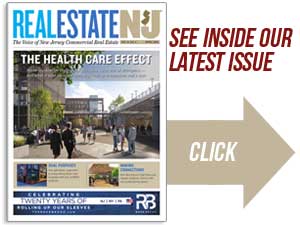David Winslow, a senior vice president with GZA GeoEnvironmental Inc., joined the firm in 2004 and has led its New Jersey team since 2011. — Photo by Aaron Houston for Real Estate NJ
By Joshua Burd
The promise of a growing business can be a difference-maker in the war for talent. Just ask David Winslow, who leads GZA GeoEnvironmental Inc.’s New Jersey team and a platform that has both expanded and evolved in recent years.
“A lot of what we’re doing is for our people,” he said. “We want to make a workplace where they can come in and be exposed to different engineering disciplines, have excitement when they come to work and see interesting projects. And the more we can diversify within our core service field, the more opportunities we have for our people.”
GZA has followed that mantra with a record of steady, organic growth and key acquisitions that have strengthened both its foothold and its technical prowess in the region. The firm’s presence in New Jersey has grown from 40 professionals in 2017 to nearly 120 today, with services that include geotechnical engineering, environmental consulting and planning, among others.
Its gross revenue in the state has increased during that span from roughly $9 million to a projected $24 million to $25 million this year, thanks in part to its role in many key development and infrastructure projects. Those assignments have ranged from Bridge Industrial’s 4 million-square-foot industrial campus in Phillipsburg and Lopatcong to the Gov. Mario M. Cuomo Bridge connecting New York’s Rockland and Westchester counties.
“There’s more competition for people,” said Winslow, a senior vice president with GZA, an employee-owned firm based in Norwood, Massachusetts, with local offices in Fairfield, Somerset and Hammonton. “So you have to be creative in making sure that you are letting the potential candidates know that this is a good opportunity.”
GZA’s New Jersey team consisted mostly of environmental consultants in early 2018, when it acquired Melick-Tully & Associates PC, a well-established, well-respected geotechnical engineering firm based in Somerset County with a staff of 50 and a long list of commercial real estate clients. Weeks later, it announced the acquisition of Civil Dynamics, a six-person dam engineering and water resources firm based in Sussex County.
Its most recent deal in New Jersey came early this year with the addition of Equity Environmental Engineering, a 20-year-old firm with a team of 16, whose presence in New Jersey and New York provided a strong match. Importantly, it also fulfilled another long-held objective for GZA: adding urban planning and land use services to better serve its commercial real estate clients in the region.
“Equity’s strong capabilities are a natural extension of the five core services currently offered by GZA — environmental consulting, geotechnical engineering, natural resources consulting, water resources engineering and construction management — and will help GZA expand and deepen our ability to serve clients throughout the Mid-Atlantic,” Patrick Sheehan, GZA’s CEO and president, said at the time. “Equity’s environmental planning expertise also dovetails strategically with GZA’s service focus and will enable us to be even more responsive to commercial, industrial and residential development clients with complex land use and zoning needs, particularly in the (New York/New Jersey metro) area.”
Winslow is quick to note that GZA prefers for its growth to be mostly organic, while using acquisitions to bolster its platform. Both have been true in recent years with New Jersey’s warehouse boom and the redevelopment of complicated, often contaminated sites that may need to be both reinforced and remediated, helping to fuel demand for geotechnical engineering and its largest core service, environmental consulting.
That could change as the industrial market cools, Winslow said. He added that the nearly 15-year-old Licensed Site Remediation Professional program, which has allowed private-sector consultants to spearhead cleanups on behalf of state regulators, has eased what was a large backlog of contaminated sites in New Jersey. That means environmental needs could become more transactional in the years ahead, he said, while also noting that regulators have become more painstaking in giving final approvals to cleanups handled by so-called LSRPs.
Still, GZA’s environmental, engineering and land use teams figure to play a prominent role in what Winslow sees as other long-term growth engines, including resiliency and climate change.
“That’s not going away,” said Winslow, who joined GZA in 2004 and has led its New Jersey team since 2011. He cited the need to build projects that are protected from rising sea levels and for solutions such as living shorelines, which can absorb floodwater more effectively than a traditional bulkhead.
“It’s all about (handling) this water. It’s going to come from rain or from the sea, and we know it’s going to come in, but if we can channel it into areas where it’s less of an impact and then have it infiltrate into the ground quicker, that’s what we need to do from that perspective,” Winslow said. “So I think that’s going to be a big place for growth.”
He expects the same for infrastructure, he said, pointing to the trillions of dollars in funding that’s been allocated under federal legislation adopted in 2021 and 2022, which is now starting to be disbursed at the local, county and state levels.
“No matter what, in the future, infrastructure’s always going to be a need in this country,” he said.
Importantly, that makes it all the more likely that GZA will be able to recruit with the promise of not only growth, but the chance to “do interesting work” with a broad impact.
“One of the good things about the civil engineering and environmental fields is it’s a rewarding career,” Winslow said. “We do things that are good for society, whether it’s building a bridge that everyone’s going to use, cleaning up a hazardous waste site or helping to stop floods from sea level rise. You can point to it and say, ‘I worked on that, we did that and that was a net benefit to society.’”










